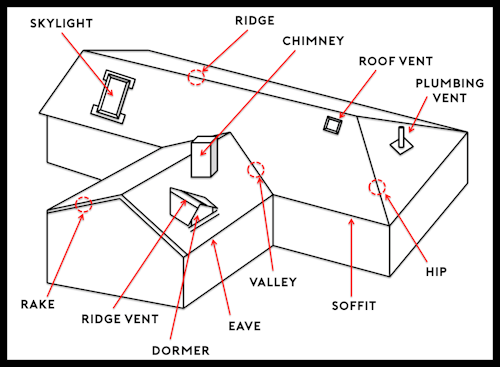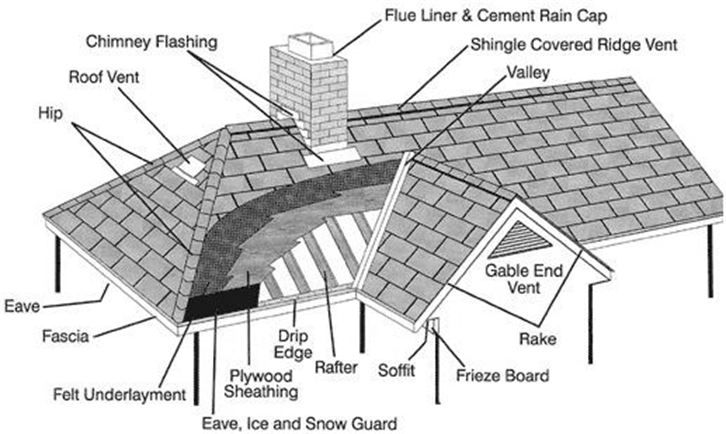DIAGNOSING YOUR LEAKING ROOF
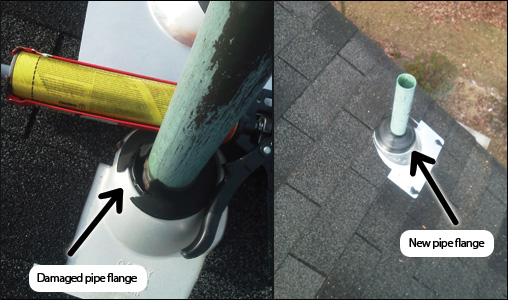 Damaged Pipe Flange
Damaged Pipe Flange
One of the most common issues that tend to make a roof leak is an old or damaged pipe flange. A pipe flange is a piece of flashing that is installed around any plumbing or ventilation PVC pipe that exits through your roof. These pipes could be used to vent anything from radon to a simple bathroom vent. A pipe flange has either an aluminum or plastic base that is mounted to the roof deck and has a rubber flange that seals tight to the PVC plumbing pipe that exits though the roof. This rubber flange will dry out and crack, leaving an opening for water to enter the attic. Depending on a number of different factors, i.e., how exposed your roof is to the sun, attic temperature and/or rapid heating and cooling can all cause the rubber to dry out and the expansion and contraction can cause the cracking. On average, depending on the house, a pipe flange can last anywhere from 8 to 15 years after the new roof was installed. Welsh Roofing only installs the highest quality materials and thanks to our one-of-a-kind installation technique, we offer lifetime warranties on our labor.
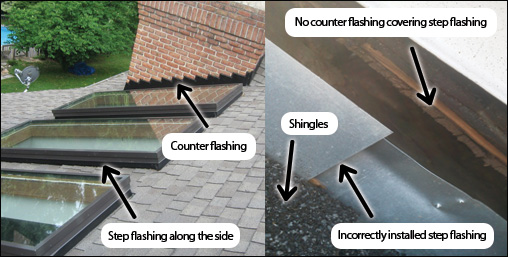 Flashing
Flashing
Incorrectly installed flashing can lead to massive roofing issues. When your roof shingles meet a wall step flashing is installed to prevent water from entering the gap between the shingles and the wall. Welsh Roofing uses aluminum, 90-degree pre-bent step flashing that is installed over the first shingle and is bent up the wall, then covered by the next shingle above it. That process (shingle, step flashing, shingle, step flashing) is then continued up the wall to the top. This allows water to flow down the roof with no gaps left for water to enter. Counter flashing is then installed over the portion of the step flashing that is bent up the wall (only on brick or stone walls). The counter flashing is secured by nails and is later caulked at the top so there is no entrance for water to get behind either the counter flashing or the step flashing. If any part of this process has been installed incorrectly water will be able to enter and cause extensive damage to your home.
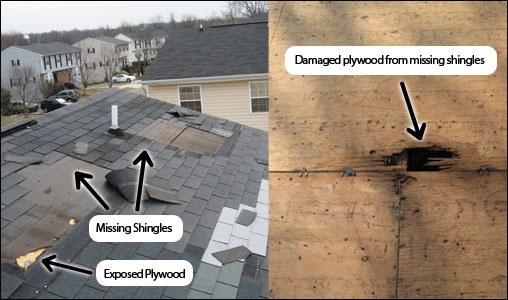 Missing Shingles
Missing Shingles
One of the more common issues with an ageing roof is shingles will start to blow off. All shingles have a tar seal strip. When your new roof is installed, the sun will heat up this tar strip and the shingles then melt together. This seal strip is what keeps high winds from getting under the shingles and prevents them from blowing off. As your roof ages, it becomes easier for this seal strip to start failing and easier for the winds to get under the shingles. Loss of shingles can lead to extensive damage to your roof deck and later lead to damage inside your home. Even the loss of one shingle is nothing to overlook. Each shingle needs to be overlapped to the manufacturers standards to prevent the roof from leaking. Welsh Roofing only uses the highest quality materials, many of which have lifetime warranties. When combined with Welsh Roofing’s lifetime labor warranty, homeowners are left with a sense of security, knowing that having a leaky roof is a thing of the past.
VENTILATION & RIDGE VENT
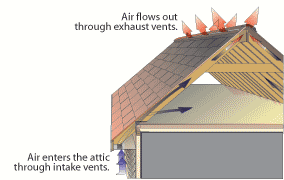 A properly ventilated attic is very important to the longevity of your roof.
A properly ventilated attic is very important to the longevity of your roof.
When Welsh Roofing installs any new roof or roof replacement project, ridge vent is always installed at the peak of the roof. Ridge vent is installed at the peak of the roof to allow the outside air to enter through soffit vents which are located on the overhang of the house underneath and behind the gutters. Outside air enters though these soffit vents into the attic.
This outside air then pushes the hot air that is already in the attic up and out though the ridge vent. Having both soffit vents and ridge vent allows air to circulate though the attic without restriction. An attic that is not properly ventilated traps hot air and will age your new roof faster, because of the hot sun beating down on the surface of the shingles and the hot air trapped in the attic will heat the shingles on both sides. This, in return, acts as a double baking effect and will deteriorate the shingles much faster than the extended manufacturer’s warranty covers.
A poorly ventilated attic can have other side effects. Mold and mildew buildup is more likely and, in the winter, ice damming, forms along the gutter line and any overhangs on the roof. Mold and mildew can form when moist and humid air is trapped in the attic because of lack of ventilation and the air is not constantly circulating in through the soffit vent and out through the ridge vent. In the winter, ice damming is a common problem when a roof does not have ridge vent installed.
Ice damming occurs when there is snow buildup on the roof. The hot air that rises from the house into the attic then melts the snow back to water. The water from the melted snow then will run downhill to the gutter where it then re-freezes, because at the gutter line, it is no longer being affected by the heat from the attic. This is what creates an ice dam. After this ice dam has blocked the remaining melted snow from flowing to the gutter, the water then backs up and will work its way under the shingles and into your house. Having Welsh Roofing install your new roof greatly reduces your chance of having any of these problems. Welsh Roofing installs ridge vent on the peak and Winterguard on the eaves to allow the attic to vent properly and protect against the winter ice damming. With the lifetime warranty Welsh Roofing offers, homeowners have never been more satisfied with our quality craftsmanship.
ROOFING TERMS
